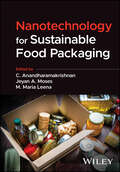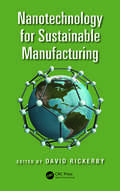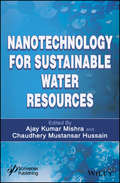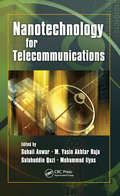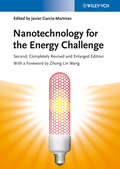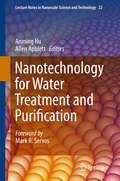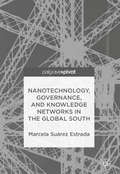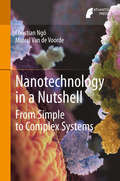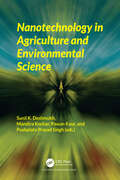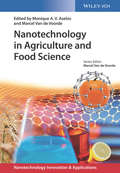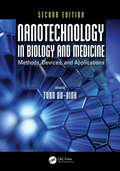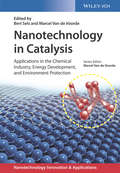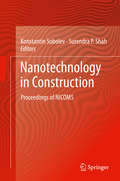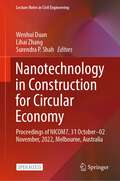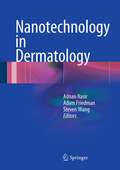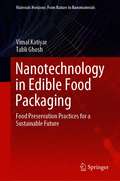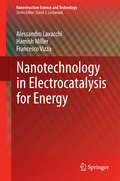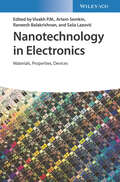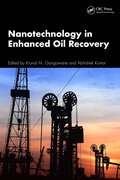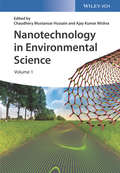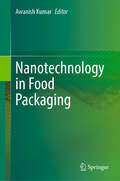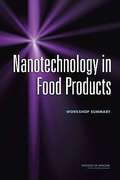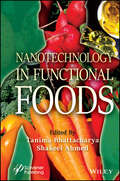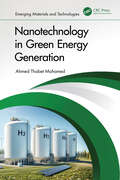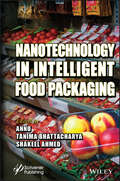- Table View
- List View
Nanotechnology for Sustainable Food Packaging
by C. Anandharamakrishnan Jeyan A. Moses M. Maria LeenaLatest techniques for the development of biodegradable food packaging casings with commentary on safety concerns and regulatory frameworks Nanotechnology for Sustainable Food Packaging covers the latest techniques and applications of nanotechnology, demonstrating capabilities to revolutionize the food packaging sector. This includes concepts of biodegradable food packaging, approaches to improve material functionality, robust sensing systems, and the scope of employing advanced analytical and computational approaches to support progress in the field. Throughout, the text focuses on the United Nations Sustainable Development Goals, including life cycle analysis, biodegradability, green practices, eco-friendliness, and sustainability. This book explores the major food packaging matrixes (polymers, edible films, and multilayers), different categories of advances (composites, active and intelligent packaging), labeling considerations, region- and country-specific regulatory frameworks, and safety concerns. Readers will also find a futuristic preview of this rapidly advancing field and an overview of lab-ready technologies with the potential for commercialization. Written by a team of highly qualified authors, Nanotechnology for Sustainable Food Packaging discusses sample topics including: Nanotechnology’s potential to improve the shelf life of food products, the chemistry and functionality of different materials based on merits and possible challengesSources, chemistry, and functionality of various bio-based sources and their usage as nanocomposites, and bio-based alternatives, drawbacks, and research trendsBioactive compounds in food packaging and their benefits, preparation methods, characterization approaches, delivery, and assessmentSurface modification approaches through sustainable physico-chemical approaches, and the development of flexible packaging materials suitable for specific requirements such as nonthermal processing Nanotechnology for Sustainable Food Packaging is an essential scientific and technological reference for scientists and R&D personnel who are interested in advancing food packaging technologies. The book is also valuable for students, researchers, and food industry professionals studying nanotechnology in food, food packaging, and food science and technology.
Nanotechnology for Sustainable Manufacturing
by David RickerbyNanomaterials have the potential to contribute to more sustainable manufacturing through cleaner, less wasteful production processes and can substitute conventional materials, leading to savings in raw materials and energy. This book provides an innovative perspective by establishing connections between the subject areas associated with nanotechnology and by bridging academic and industrial research. It also covers methods for assessing the sustainability of nanotechnology-based products and processes using life-cycle analysis, taking into account material and energy consumption during manufacture, use, and final disposal and/or recycling.
Nanotechnology for Sustainable Water Resources
by Ajay Kumar Mishra Prof. Chaudhery Mustansar HussainIn this book, we have summarized recent progresses due to novel nanomaterials for sustainable water resources. Book provides a summary of the state of the art knowledge to scientists, engineers and policy makers, about recent developments due to nanotechnology for sustainable water resources arena. The advances in sustainable water resources technologies in the context of modern society’s interests will be considered preferably which allow to identify grand challenges and directions for future research. The book contributors have been selected from all over the world and the essential functions of the nanotechnologies have presented rather than their anticipated applications. Moreover, up to date knowledge on economy, toxicity and regulation related to nanotechnology are presented in detail. In the end, role of nanotechnology for green and sustainable future has also been briefly debated.
Nanotechnology for Telecommunications
by Sohail Anwar M. Yasin Akhtar Raja Salahuddin Qazi Mohammad IlyasWith its unique promise to revolutionize science, engineering, technology, and other fields, nanotechnology continues to profoundly impact associated materials, components, and systems, particularly those used in telecommunications. These developments are leading to easier convergence of related technologies, massive storage data, compact storage devices, and higher-performance computing. Nanotechnology for Telecommunications presents vital technical scientific information to help readers grasp issues and challenges associated with nanoscale telecommunication system development and commercialization—and then avail themselves of the many opportunities to be gleaned. This book provides technical information and research ideas regarding the use of nanotechnology in telecommunications and information processing, reflecting the continuing trend toward the use of optoelectronics. Nanotech will eventually lead to a technology cluster that offers a complete range of functionalities for systems used in domains including information, energy, construction, environmental, and biomedical. Describing current and future developments that hold promise for significant innovations in telecommunications, this book is organized to provide a progressive understanding of topics including: Background information on nanoscience and nanotechnology Specific applications of nanotechnology in telecommunications Nanostructured optoelectronic materials MEMS, NEMS, and their applications in communication systems Quantum dot Cellular Automata (QCA) and its applications in telecommunication systems How nonohmic nonlinear behavior affects both digital and analog signal processing Concepts regarding quantum switching and its applications in quantum networks The scale of the physical systems that use nanoscale electronic devices is still large, and that presents serious challenges to the establishment of interconnections between nanoscale devices and the outside world. Also addressing consequent social implications of nanotech, this book reviews a broad range of the nano concepts and their influence on every aspect of telecommunications. It describes the different levels of interconnections in systems and details the standardized assembly process for a broad specrum of micro-, nano-, bio-, fiber-optic, and optoelectronic components and functions. This book is a powerful tool for understanding how to harness the power of nanotech through integration of materials, processes, devices, and applications.
Nanotechnology for the Energy Challenge
by Javier García-Martínez Zhong Lin WangWith the daunting energy challenges faced by Mankind in the 21st century, revolutionary new technologies will be the key to a clean, secure and sustainable energy future. Nanostructures often have surprising and very useful capabilities and are thus paving the way for new methodologies in almost every kind of industry.This exceptional monograph provides an overview of the subject, and presents the current state of the art with regard to different aspects of sustainable production, efficient storage and low-impact use of energy.Comprised of eighteen chapters, the book is divided in three thematic parts:Part I Sustainable Energy Production covers the main developments of nanotechnology in clean energy production and conversion, including photovoltaics, hydrogen production, thermal-electrical energy conversion and fuel cells.Part II Efficient Energy Storage is concerned with the potential use of nanomaterials in more efficient energy storage systems such as advanced batteries, supercapacitors and hydrogen storage.Part III Energy Sustainability shows how nanotechnology helps to use energy more efficiently, and the mitigation of impacts to the environment, with special emphasis on energy savings through green nanofabrication, advanced catalysis, nanostructured light-emitting and eletrochromic devices and CO2 capture by nanoporous materials .An essential addition to any bookshelf, it will be invaluable to a variety of research fields including materials science, chemical engineering, solid state, surface, industrial, and physical chemistry, as this is a subject that is very interdisciplinary.
Nanotechnology for Water Treatment and Purification
by Anming Hu Allen ApblettThis book describes the latest progress in the application of nanotechnology for water treatment and purification. Leaders in the field present both the fundamental science and a comprehensive overview of the diverse range of tools and technologies that have been developed in this critical area. Expert chapters present the unique physicochemical and surface properties of nanoparticles and the advantages that these provide for engineering applications that ensure a supply of safe drinking water for our growing population. Application areas include generating fresh water from seawater, preventing contamination of the environment and creating effective and efficient methods for remediation of polluted waters. The chapter authors are leading world-wide experts in the field with either academic or industrial experience, ensuring that this comprehensive volume presents the state-of-the-art in the integration of nanotechnology with water treatment and purification.
Nanotechnology, Governance, and Knowledge Networks in the Global South
by Marcela Suárez EstradaThe seemingly unlimited technological potential of nanotechnology brings with it new practices of governance, networking, and exercising power and agency. Focusing on scholars in the Global South, this text covers nanotechnology discourses, imaginaries, and materialities as they circulate and interact within governance knowledge networks. Rather than adapt their actions to existing governance mechanisms and science, technology, and innovation policy, scientists use the imaginary of nanotechnology to create new symbolic and material incentives, thus shaping its governance. By tracing the constantly shifting asymmetries of knowledge and power, the book offers fresh insights into the dynamics of knowledge networks.
Nanotechnology in a Nutshell
by Christian Ngô Marcel Van de VoordeA new high-level book for professionals from Atlantis Press providing an overview of nanotechnologies now and their applications in a broad variety of fields, including information and communication technologies, environmental sciences and engineering, societal life, and medicine, with provision of customized treatments. The book shows where nanotechnology is now - a fascinating time when the science is transitioning into complex systems with impact on new products. Present and future developments are addressed, as well as a larger number of new industrial and research opportunities deriving from this domain. An overview for professionals, researchers and policy-makers of this very rapidly expanding field. Brief chapters and colour figures with a contained overall length make the book attractive at an attractive price - a must for every professional's shelf. Mihail C. Roco, National Science Foundation and National Nanotechnology Initiative, wrote the preface underlying the importance and weight of the present book to this exciting and epoch-awakening field of research and applications: "Nanotechnology is well recognized as a science and technology megatrend for the beginning of the 21st century. This book aims to show where nanotechnology is now - transitioning to complex systems and fundamentally new products - and communicates the societal promise of nanotechnology to specialists and the public. Most of what has already made it into the marketplace is in the form of "First Generation" products, passive nanostructures with steady behaviour. Many companies have "Second Generation" products, active nanostructures with changing behaviour during use, and embryonic "Third Generation" products, including 3-dimensional nanosystems. Concepts for "Fourth Generation" products, including heterogeneous molecular nanosystems, are only in research. "
Nanotechnology in Agriculture and Environmental Science
by Sunil K. Deshmukh Mandira Kochar Pawan Kaur Pushplata Prasad SinghThis book provides examples applications of nanotechnology in addressing problems and challenges in agriculture as well as environmental sciences and provides an overview of innovations in nanopesticides, nanofertilizers, bionanosensors and nano-based delivery system for improving different aspects of plant productivity including pre-harvest and post-harvest strategies as well detection of contaminants that could be useful for enhancing soil health. Recycling of agricultural waste to beneficial products using nanotechnologies; bionanosensors; fate of nanomaterials and the ecological consequences of their delivery into the environment; safety and nanotoxicity issues are other topics being dealt with in this book. Chapters have been written by internationally recognized researchers and experts with special reference to the innovations and latest developments in the mentioned areas of nanobiotechnology that have applications and commercial importance, especially for crop fields and post-harvest management. Despite the research and development used to promote the use of nanotechnology in agriculture and the environmental, knowledge gaps and uncertainties about how to fill the gaps are more prevalent than scientific certainties about the public health and environmental effects of nanomaterials. The book thus addresses the issue of toxicity of nanomaterials in agricultural nanotechnology products. The book will be useful for active researchers and scientists in the agricultural sector, academia as well as industry, including nanotechnologists, plant pathologists, agronomists, agrochemists, environmental technologists and all scientists working for sustainability in agriculture. The book will encourage future and active researchers and scientists in the agriculture sector, academia as well as industry.
Nanotechnology in Agriculture and Food Science
by Marcel Van de Voorde Monique A. AxelosA comprehensive overview of the current state of this highly relevant topic. An interdisciplinary team of researchers reports on the opportunities and challenges of nanotechnology in the agriculture and food sector, highlighting the scientific, technical, regulatory, safety, and societal impacts. They also discuss the perspectives for the future, and provide insights into ways of assuring safety so as to obtain confidence for the consumer, as well as an overview of the innovations and applications. Essential reading for materials and agricultural scientists, food chemists and technologists, as well as toxicologists and ecotoxicologists.
Nanotechnology in Biology and Medicine: Methods, Devices, and Applications, Second Edition
by Tuan Vo-DinhThe second edition of Nanotechnology in Biology and Medicine is intended to serve as an authoritative reference source for a broad audience involved in the research, teaching, learning, and practice of nanotechnology in life sciences. This technology, which is on the scale of molecules, has enabled the development of devices smaller and more efficient than anything currently available. To understand complex biological nanosystems at the cellular level, we urgently need to develop a next-generation nanotechnology tool kit. It is believed that the new advances in genetic engineering, genomics, proteomics, medicine, and biotechnology will depend on our mastering of nanotechnology in the coming decades. The integration of nanotechnology, material sciences, molecular biology, and medicine opens the possibility of detecting and manipulating atoms and molecules using nanodevices, which have the potential for a wide variety of biological research topics and medical uses at the cellular level. This book presents the most recent scientific and technological advances of nanotechnology for use in biology and medicine. Each chapter provides introductory material with an overview of the topic of interest; a description of methods, protocols, instrumentation, and applications; and a collection of published data with an extensive list of references for further details. The goal of this book is to provide a comprehensive overview of the most recent advances in instrumentation, methods, and applications in areas of nanobiotechnology, integrating interdisciplinary research and development of interest to scientists, engineers, manufacturers, teachers, and students.
Nanotechnology in Catalysis: Applications in the Chemical Industry, Energy Development, and Environment Protection
by Bert Sels Marcel Van de VoordeReflecting the R&D efforts in the field that have resulted in a plethora of novel applications over the past decade, this handbook gives a comprehensive overview of the tangible benefits of nanotechnology in catalysis. By bridging fundamental research and industrial development, it provides a unique perspective on this scientifically and economically important field. While the first three parts are devoted to preparation and characterization of nanocatalysts, the final three provide in-depth insights into their applications in the fine chemicals industry, the energy industry, and for environmental protection, with expert authors reporting on real-life applications that are on the brink of commercialization. Timely reading for catalytic chemists, materials scientists, chemists in industry, and process engineers.
Nanotechnology in Construction
by Konstantin Sobolev Surendra P. ShahNanotechnology has already demonstrated surprising potential for improving the performance of construction materials and many of these recent developments were facilitated by NICOM symposia. The NICOM5 proceedings will cover the emerging opportunities and future use of nanotechnology in construction and will illustrate the broad potential for application of nanotechnology to challenging problems involving materials and infrastructure.
Nanotechnology in Construction for Circular Economy: Proceedings of NICOM7, 31 October–02 November, 2022, Melbourne, Australia (Lecture Notes in Civil Engineering #356)
by Wenhui Duan Lihai Zhang Surendra P. ShahThis open access book covers emerging opportunities and future use of nanotechnology in construction, including deep advances in cement chemistry, nanotechnology, artificial intelligence, robotics, concrete technology, and extreme engineering (blast, impact and fire). The proceedings also presents sectorial interactions within the traditional construction industry supply chain, enabled by the dynamic partnership between international industry, government agencies, and universities. Nanotechnology has transformed the construction materials industry into an advanced manufacturing sector to address climate change and carbon neutrality challenges by delivering sustainable and resilient infrastructure assets. Hence, this book reports specific advances in nanoscience and nano-engineering, and their impacts on numerous novel construction materials including binders, additives, high-performance concrete materials, concrete structural systems, polymer composites, and pavement materials.
Nanotechnology in Dermatology
by Adam Friedman Steven Wang Adnan NasirNanotechnology in Dermatology is the first book of its kind to address all of the important and rapidly growing aspects of nanotechnology as it relates to dermatology. In the last few years there has been an explosion in research and development for products and devices related to nanotechnology, including numerous applications for consumers, physicians, patients, and industry. Applications are underway in medicine and dermatology for the early detection, diagnosis, and targeted therapy of disease, and nanodesigned materials and devices are expected to be faster, smaller, more powerful, more efficient, and more versatile than their traditional counterparts. Written by experts working in this exciting field, Nanotechnology in Dermatology specifically addresses nanotechnology in consumer skin care products, in the diagnosis of skin disease, in the treatment of skin disease, and the overall safety of nanotechnology. The book also discusses future trends of this ever-growing and changing field, providing dermatologists, pharmaceutical companies, and consumer cosmetics companies with a clear understanding of the advantages and challenges of nanotechnology today.
Nanotechnology in Edible Food Packaging: Food Preservation Practices for a Sustainable Future (Materials Horizons: From Nature to Nanomaterials)
by Vimal Katiyar Tabli GhoshThis volume delivers a systematic overview of nanotechnology in the development of edible food packaging with noteworthy characteristics for improved food quality. It covers current research trends, history outlines, and state of the global marketin combination with associated biomaterials and synthesis strategies. The contents detail the use of various emerging bionanostructured materials such as cellulose nanostructures, chitosan nanostructures, and more.It further deliberates an in-depth discussion on various synthesis strategies and routes for the development of edible food packaging in terms of utilizing various nanosystems such as polymeric nanocomposites, nanoencapsulation systems, nanoemulsion systems, and others.Further, it also discusses experimental practices for bionanostructured and edible packaging materials to check the effectivity in terms of offering enhanced shelf life of food products. It also touches upon the socio-techno challenges in-line with developing edible packaging materials using nanotechnology for high performance packaging application. The book is an excellent guide for both the academia and industry especially early career professionals in edible food packaging sectors for selecting proper biomaterial involvingbiofillers, modifiers, cross linkers, compatibilizers and others to enhance the property of edible food packaging for targeted features.^
Nanotechnology in Electrocatalysis for Energy
by Alessandro Lavacchi Hamish Miller Francesco VizzaThis book focuses on nanotechnology in electrocatalysis for energy applications. In particular the book covers nanostructured electrocatalysts for low temperature fuel cells, low temperature electrolyzers and electrochemical valorization. The function of this book is to provide an introduction to basic principles of electrocatalysis, together with a review of the main classes of materials and electrode architectures. This book will illustrate the basic ideas behind material design and provide an introductory sketch of current research focuses. The easy-to-follow three part book focuses on major formulas, concepts and philosophies. This book is ideal for professionals and researchers interested in the field of electrochemistry, renewable energy and electrocatalysis.
Nanotechnology in Electronics: Materials, Properties, Devices
by Visakh P. M. Artem Semkin Raneesh Balakrishnan Saša LazovićNanotechnology in Electronics Enables readers to understand and apply state-of-the-art concepts surrounding modern nanotechnology in electronics Nanotechnology in Electronics summarizes numerous research accomplishments in the field, covering novel materials for electronic applications (such as graphene, nanowires, and carbon nanotubes) and modern nanoelectronic devices (such as biosensors, optoelectronic devices, flexible electronics, nanoscale batteries, and nanogenerators) that are used in many different fields (such as sensor technology, energy generation, data storage and biomedicine). Edited by four highly qualified researchers and professionals in the field, other specific sample topics covered in Nanotechnology in Electronics include: Graphene-based nanoelectronics biosensors, including the history, properties, and fundamentals of graphene, plus fundamentals of graphene derivatives and the synthesis of graphene Zinc oxide piezoelectronic nanogenerators for low frequency applications, with an introduction to zinc oxide and zinc oxide piezoelectric nanogenerators Investigation of the hot junctionless mosfets, including an overview of the junctionless paradigm and a simulation framework of the hot carrier degradation Conductive nanomaterials for printed/flexible electronics application and metal oxide semiconductors for non-invasive diagnosis of breast cancer The fundamental aspects and applications of multiferroic-based spintronic devices and quartz tuning fork based nanosensors. Containing in-depth information on the topic and written intentionally to help with the practical application of concepts described within, Nanotechnology in Electronics is a must-have reference for materials scientists, electronics engineers, and engineering scientists who wish to understand and harness the state of the art in the field.
Nanotechnology in Enhanced Oil Recovery
by Krunal M. Gangawane Abhishek KumarThis book presents an in-depth analysis of the various nanotechnologies that have been developed and their potential application in enhanced oil recovery (EOR). It begins with an introduction to EOR, and the current state of the oil and gas industry followed by discussion of various nanoparticles used in EOR, including metal and metal oxide nanoparticles, carbon-based nanoparticles, and composite nanoparticles.Features Explains the various mechanisms by which nanoparticles can enhance oil recovery, and the challenges and limitations of using nanotechnology in EOR. Provides a comprehensive analysis of how nanoparticles affect EOR, practical application, and simulation. Explores stepwise information about the utility of nanotechnology in EOR. Includes dedicated case study chapters to get an in-depth idea of EOR by using nanotechnology. Illustrates various essential parameters affecting the EOR. Discusses the challenges of nanotechnology-based EOR. This book is aimed at graduate students, researchers, and professionals in Petroleum and Chemical Engineering, and Nanotechnology.
Nanotechnology in Environmental Science
by Chaudhery Mustansar Hussain Ajay Kumar MishraAn overview of the current state of nanotechnology-based devices with applications in environmental science, focusing on nanomaterials and polymer nanocomposites. The handbook pays special attention to those nanotechnology-based approaches that promise easier, faster and cheaper processes in environmental monitoring and remediation. Furthermore, it presents up-to-date information on the economics, toxicity and regulations related to nanotechnology in detail. The book closes with a look at the role of nanotechnology for a green and sustainable future. With its coverage of existing and soon-to-be-realized devices this is an indispensable reference for both academic and corporate R&D.
Nanotechnology in Food Packaging
by Awanish KumarFor researchers and food industry professionals seeking a comprehensive, fully up to date single source on nanotechnology in food packaging, this text provides all the needed information. The book begins with a chapter on the current state of nanotechnology and its use in food packaging and the industry as a whole, including current advances in methods and technology. Further chapters address organic nano packaging for shelf life and quality retention, the use of inorganic nanomaterials, biopolymeric nano packaging and composite nano packaging materials. Nanotechnology in Food Packaging focuses on the methods of synthesis for nano-based food packaging materials and the fabrication of improved, active and smart packaging materials. Ethical issues and safety features of nanomaterials are addressed, plus the main challenges and regulatory aspects of nanomaterials in food products. An important chapter looks to the future of nanotechnology in the food packaging industry. Toxicological aspects, detection methods and analysis of nanomaterials are also covered in full. With its wide scope and up to date information on technological advancements, this is the perfect source for those seeking knowledge on the use of nanotechnology in the food industry.
Nanotechnology in Food Products: Workshop Summary
by Institute of Medicine of the National AcademiesIn the food industry, scientists are exploring the potential of nanotechnology to enhance the flavor and other sensory characteristics of foods, introduce antibacterial nanostructures into food packaging and encapsulate and deliver nutrients directly into targeted tissues, among other applications. However, as with any new technology, along with the benefits, there is the potential for unanticipated adverse effects. There is still a great deal to learn about any health outcomes related to introducing nanosized materials into foods and food packaging materials. Developing nanotechnology into a safe, effective tool for use in food science and technology will require addressing these and other questions. Assuring consumer confidence will be equally important to the success of this new emerging technology. The Institute of Medicine held a one-day workshop, summarized in this volume, to further explore the use of nanotechnology in food. Specifically, the workshop was organized around three primary topic areas: (1) the application of nanotechnology to food products; (2) the safety and efficacy of nanomaterials in food products; and (3) educating and informing consumers about the applications of nanotechnology to food products.
Nanotechnology in Functional Foods
by Tanima Bhattacharya Shakeel AhmedNANOTECHNOLOGY IN FUNCTIONAL FOODS The broad applicability of bioactive delivery systems for improving food quality, safety, and human health will make this book a valuable resource for a wide range of readers in industry, research, and academia. Functional foods is an emerging trend in the food industry, whose potential value is determined by whether they are safe with respect to consumer health. Nanotechnology in Functional Foods was written to help the reader better understand the benefits and concerns associated with these foods. In addition to giving an overview of the current state-of-the-art in functional foods, different aspects of the advanced research being conducted on their extraction, synthesis, analysis, and biological effects are presented. Besides focusing on several synthesis techniques, the book also discusses the application of nanoparticles in nutrient delivery and pharmaceuticals, such as nano-emulsions, solid lipid nanoparticles, and polymeric nanoparticles; their properties and interactions with other food components and their impact on the human body; the consumer acceptance and diversification of these nutrients. Moreover, new trends are discussed concerning the application of artificial intelligence in screening various components of functional foods. Audience The book will be central to food scientists, materials scientists, biotechnologists, medicinal chemists, pharmacists, and medical professionals. Tanima Bhattacharya, PhD, is a formulation scientist, who completed her Doctoral degree in Food Processing & Nutrition Science from the Indian Institute of Engineering Science and Technology, Shibpur, West Bengal, India and gained overseas post-doctoral experience from the College of Chemistry and Chemical Engineering Hubei University of China. She has published several scientific research articles in international peer-reviewed journals, and her research interests include the fabrication of biocompatible nanostructures and studying their properties and applications in the area of food science, technology, and biomedical sciences. Shakeel Ahmed, PhD, is an assistant professor of Chemistry at the Higher Education Department, Government of Jammu and Kashmir, India. His PhD degree in Chemistry is from Jamia Millia Islamia, A Central University, New Delhi. He has published several research publications in the area of green nanomaterials and biopolymers for various applications including biomedical, packaging, and water treatment. He has published more than 20 books in the area of nanomaterials and green materials.
Nanotechnology in Green Energy Generation (Emerging Materials and Technologies)
by Ahmed Thabet MohamedNanotechnology in Green Energy Generation provides a comprehensive review of modelling, processing, and applications of all major categories of green energy generation materials. It explores different areas of green energy generation including hydrogen, solar, and wind energies, covering aspects such as synthesis, morphology, materials, and characterization.Presenting the fundamental principles in the design and utilization of green energy generation materials, the book discusses the construction and equivalent circuits of traditional and new green energy cells. In addition, it provides thermal analysis and comparative studies with traditional power generation, including operation and cost-efficiency of new generation cells and modules. The book also includes many case studies, laboratory experiments, and research results throughout the chapters.The book will be a valuable reference for applied researchers, academic researchers and graduate students studying advances in energy engineering, nanotechnology, and materials and composites.
Nanotechnology in Intelligent Food Packaging
by Annu Tanima Bhattacharya Shakeel AhmedNANOTECHNOLOGY IN INTELLIGENT FOOD PACKAGING This book is a state-of-the-art exposition of nanotechnology and food packaging which is undergoing rapid advancement. This book is specially designed with an emphasis on the state-of-the-art in nanotechnology and food packaging. It offers fascinating techniques for producing smart and active food packaging and also discusses its toxicity and the role that nanosensors play in detecting different pathogens in food packaging. The concluding chapters also explain recent developments concerning the incorporation of health supplements in food packaging and their future role in producing intelligent food packaging. The 16 chapters of this book were contributed by academic and industry experts working in their respective areas of research and are thoughtfully arranged in a systematic fashion that preserves the flow of knowledge. An attempt has been made to include all the information in a single monograph to better understand the topics and technologies involved in the application of nanotechnology in intelligent food packaging. Audience The book is aimed at researchers, industry scientists such as chemists, biologists, polymer technologists, food packaging industrialists, biotechnologists, health experts, quality/food safety officials, and policymakers. It will also be helpful to graduate students in the fields of materials science, polymer science, and biotechnology to better understand the fundamental concepts involved in food packaging in relation to extending shelf life.
